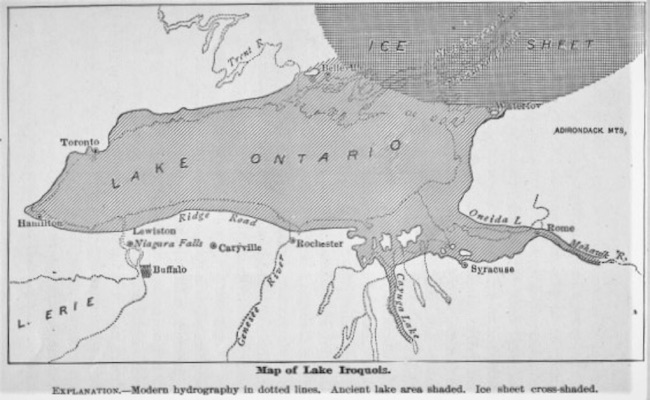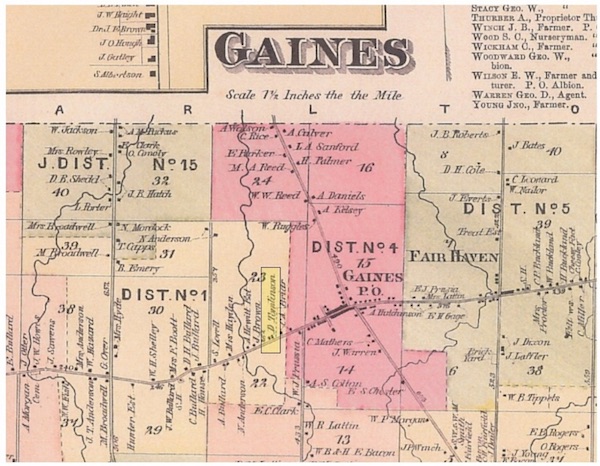Historic Childs: Natural History, Part 1 – Native Peoples
By Doug Farley, Cobblestone Museum Director – Vol. 2 No. 35
Our efforts to date with the “Historic Childs” article series have focused on 19th and 20th century history, today we take a venture into much, much earlier territory.
I believe the first printed telling of this historic discovery appeared in the “Holley Standard” newspaper on January 6, 1887. The subject of the article concerned an 1814 discovery in the Town of Gaines that scholars over the years have confirmed to date from a pre-Ice Age, Paleo-Indian settlement, dating back over 12,000 years ago.
The scene of the local discovery in 1814 was at the David Tomlinson Farm located on Ridge Road just west of the Village of Gaines. At that time, the region was largely unbroken forest. About 150’ off the Ridge, there was a well-known fresh water spring that the Native Peoples had shown to the settlers in the early 1800s.
In 1824, the spring was cleaned out and stones were built up to form a well. In 1853, the well failed and was subsequently deepened to replenish the water supply. In 1864, the farm experienced a dry well which necessitated a second re-digging to the 18’ level. It was at that level that the prehistoric discovery was made which was described in detail in the Holley newspaper:
“About 18’ below the original surface, the digger came upon a quantity of brush overlying an ancient fireplace, consisting of three round stones, each about one foot in diameter, placed in the form of a triangle. A mess of charcoal and ashes surrounded the stones, which were burned and blackened by fire and smoke. Several sticks were found thrust between the stones, the inner ends burned and charred as left by the expiring flames. A careful inspection of these sticks by a gentleman thoroughly acquainted with the nature and grain of various woods proved them to be hemlock and ash.
“Some were denuded of bark and had the smooth surface usually presented by water washed wood found on any beach. Several sticks were split and surrounding one was a depressed ring or indentation, as through some dull instrument had been employed in an effort to weaken or break the wood. The ashes were indurated to a degree requiring the use of a pick in their removal and rested upon a stratum of sand which was also in a hardened condition, being taken out in large pieces that proved to be fine grained with a smooth surface, slightly creased in places, possibly ripple marks.
“When first discovered the brush was closely packed over the fireplace and had every appearance of having been forced into position by the action of water. The fireplace and all the details of its narrow surroundings, which were carefully noted, clearly indicated that it had been made upon a sand beach and was subjected to an inundation that washed the mass of brush, possibly gathered for fuel, over the stones and ashes, which were afterwards covered many feet deep by successive strata of the same gravelly soil of which the Ridge is composed, and was preserved for ages unknown.
After ascertaining these facts, and after looking over the ground, the observer reached the conclusion that the fireplace must have been made at a period just before the formation of the Ridge. The Ridge at that point in time must has been a (sand) bar like that on the present lake shore behind which lies a little round pond. The waters of the pond or marsh, finally soaked thru the mud bottom and following a vein or seam, rose to the surface in the formation of the spring. When the marsh land was cleaned and drained the spring failed. All this would go to show that man was a habitant of the lake shore before the existence of the Ridge. The late Lewis H. Morgan thought the discovery an important one and advised its publication.
At a late meeting of the Anthropological Society of Washington, G. K. Gilbert of the U.S. Geological Survey, retold the story of the find as verified by himself on the occasion of his visit to this vicinity.”

Grove Karl (G. K.) Gilbert (1843-1918), Rochester NY
The find, at that time, was labeled “Gilbert’s Hearth.” Professor Gilbert’s findings were recorded in the Handbook of Aboriginal American Antiquities, 1919. He stated that the terrace on which the Tomlinson site sits is located about 175’ above the present level of Lake Ontario. The formation occurred between the ice front on the north and the southern rim of the basin. When the basin was finally free from ice, the lake outflowed via the Mohawk Valley and the present terrace was formed.
Gilbert concluded that the hearth was made in the period following the Ice Age outflow at the Mohawk Valley in a period of time that reflected the decline of the glacial climate.
Next week, in Part 2 of this article, we look at how this local discovery became a dramatic influence in the life of one of Orleans County’s early citizens, Dr. Frank. H. Lattin.



























































